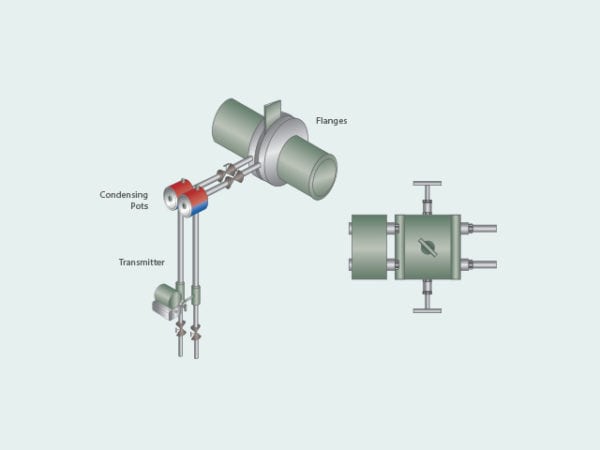No. 27 – Condensate Chambers for Steam Flow Measurement

Do you want this article in PDF format? Download it here:
Download a PDFThe basic concept of impulse tubing for steam flow instruments is the same as that behind impulse tubing for liquid flow instruments. However, additional problems are introduced in steam flow measurement because of the difference in density between the flowing fluid (steam) and the liquid (condensate) in the sensing line, which makes a condensate pot necessary to ensure an accurate, reliable steam flow measurement. The connection tubing from the flow measurement device (typically a flow orifice) to the condensate chamber is full of steam, and the tubing from the condensate chamber to the measurement instrument (differential transmitter) is full of condensate.
The chamber will maintain equal heads of the liquid on the two sides of the measuring instruments and provide a large surface area (top of the liquid) to sense and send any changes to the transmitter. The chamber will allow a larger surface area for radiant losses to ensure a proper condensate level for the sensing lines. Without the chamber, the condensate can evaporate at times and provide different liquid levels that affect the flow measurement.
Figure 1 : Condensate chamber
Figure 2: Typical installation
Installation tips:
- Use stainless steel tubing for the connection to the flanges or steam line.
2. Place the pot nearer to the steam line or flange connection points.
3. Keep both the condenser and condensate chamber at the same level as the upper connection point.
a. An unequal level will cause significant error due to false heads.
4. If the flow device (in the steam line) is installed in a vertical pipe, align the lower connection point to the steam pipe with the upper connection point.
5. For flow measurements, keep the instruments below the condensate chamber.
6. Install tubing and valves as shown in the installation guideline to allow the sensing lines to be blown down every year. This will ensure no plugging has occurred, which will affect the reading.
Figure 3: Flow metering with Condensate Chambers
7. Use the manual air vent on top of the condensate chamber for venting air at commissioning.
a. The chamber has to be rated for the maximum pressure and temperature that will occur in the steam line.













